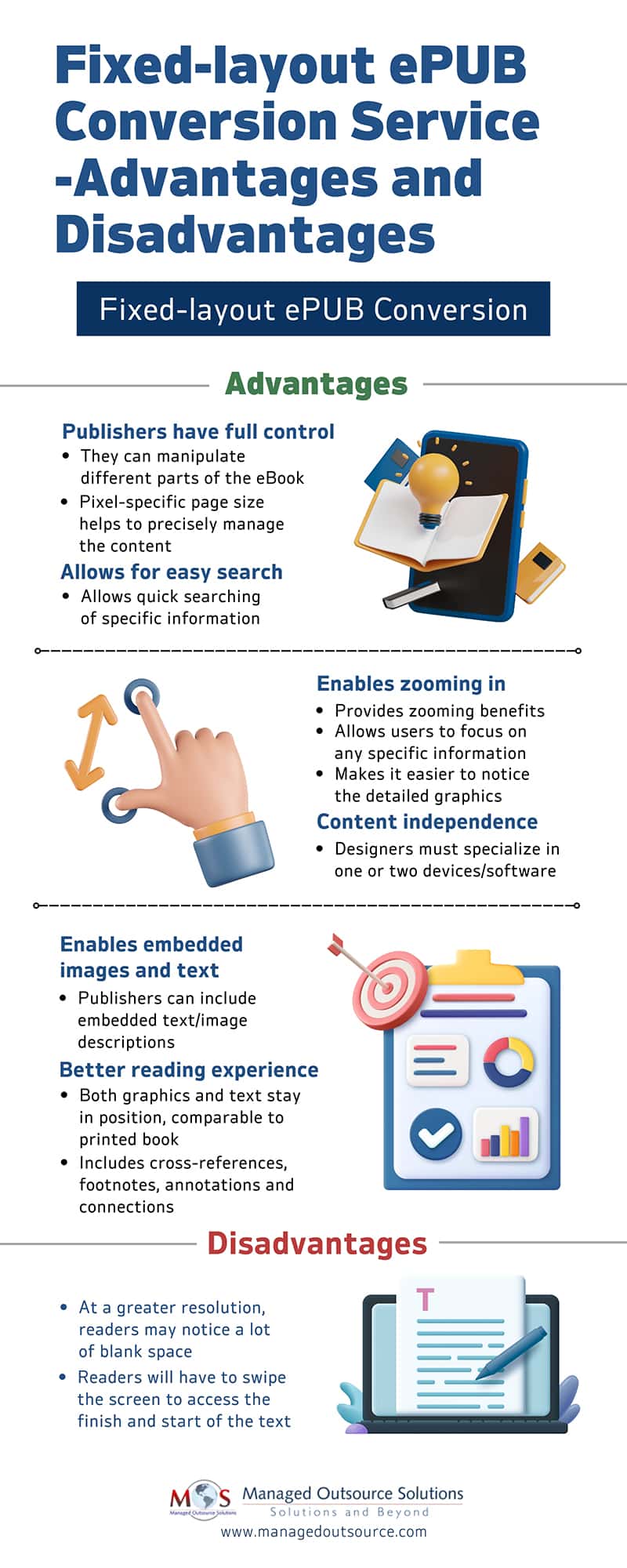Converting physical books into eBooks expand the audience. One of the best methods to turn your book into an engaging eBook is fixed-layout ePub conversion. Two main layouts that publishers can choose are – Fixed layout and Reflowable layout. While the fixed layout format has a predefined image and text location which is similar to PDF files, in the reflowable layout, the content is shown as floating text and graphics that adjust according to the screen size.
Converting physical books into interactive digital formats is a smart way to reach a wider, tech-savvy audience. One of the most effective methods for creating visually rich eBooks is through a fixed-layout ePUB conversion service. With fixed-layout eBooks, publishers can integrate multimedia elements such as read-aloud functionality, interactive animations, text highlighting, and zoomable content—making the reading experience more immersive. To ensure high-quality results, it’s advisable to work with a professional eBook conversion service provider experienced in fixed-layout ePub creation for multiple platforms and devices.
Reflowable vs Fixed Layout ePUB
There are two main digital publishing formats:
- Fixed layout- The fixed layout format has a predefined image and text location which is similar to PDF files.
- Reflowable layout- In a reflowable layout, the content is shown as floating text and graphics that adjust to the screen size.
Though the reflowable layout may look more user-friendly, the fixed layout is a popular choice, despite its limitations.
What Is Fixed-Layout ePub Conversion?
Certain eBooks necessitate a precise, uniform style and pagination. The majority of these books rely significantly on large artwork, design elements, and photographs. This means that with fixed layout eBooks, the reader cannot change specific elements such as fonts, line spacing, line margin, or text sizes on any page. Furthermore, different eBooks have varied formats, one of which is the ePUB format, depending on the target audience and the devices on which they view the content. Simply put, a fixed-layout format is a file the layout of which cannot be changed by readers, making it a popular choice.
What Are the Benefits and Drawbacks of Fixed Layout eBook Conversion?
In the ePublishing industry, ePUB is the most widely supported eBook format, compatible with platforms like Apple Books, Barnes & Noble Nook, Kobo, KITABOO, and Sony Reader. Fixed-layout ePub formatting is especially beneficial for children’s books, cookbooks, graphic novels, academic textbooks, travel guides, and other image-heavy content. This layout is preferred when precise design control is needed—such as maintaining text over images or ensuring consistent aspect ratios across devices.
Advantages
- Publishers have full control: The author or the publisher has complete control over how their eBook is displayed on the screen in the case of fixed layout. They can manipulate different parts of the eBook, from pictures to audio narration linked to texts. In contrast to the conventional ePub format, the fixed layout ePub format uses pixel-specific page size to precisely manage the arrangement of photos, text, and other objects on the pages.
- Quick and easy search option: eBook design with fixed layout provides for quick searching of specific information or a chunk of text, as well as text size selection and font embedding.
- Enables zooming in: Conventional ePUB readers allow users to increase the font size for better visibility, but they do not allow users to zoom in on photographs or images for better browsing. On the other hand, fixed-layout provides the benefit of zooming, which allows users to focus on the photos they want to see and search for specific information. This zoom in option makes it easier for the reader to notice the detailed graphics.
- Content independence: Since this format is distinct across different software and devices, content independence is another significant benefit of fixed layout format. This means that designers must specialize in one or two devices and software, thereby improving total content quality over time.
- Enables embedded images and text: Fixed-layout eBooks support illustrated content, making it the best format for children’s eBooks. Publishers can include embedded text or image descriptions in graphics and charts, making them more accessible to readers and read-aloud listeners.
- Navigation by thumbnails, bookmarks, and dictionary links.
- Audio, video, and text-to-speech features are all included.
- Allows for the creation of multi-column text pages with semantic organization for improved accessibility.
The fixed-layout eBook format also has a number of other characteristics, such as –
- Better reading experience: When it comes to graphics, fixed-layout ePUB conversion allows you to improve the entire reading experience. Text and images on e-readers frequently do not flow smoothly, causing them to stretch out or appear out of place. Publishers may ensure that both graphics and text stay in position, comparable to printed books, using the fixed layout ePub conversion function, providing a superb reading experience.
- Include cross reference: You can include cross-references, footnotes, annotations, and connections to external websites to your content when you are using fixed layout. It also enables the usage of SVG pictures that dynamically resize while maintaining definition and clarity.
- Utilizes JavaScript and CSS: Animations for elements like games, quizzes, and multiple-choice questions, as well as other interactivities, can be added using CSS and JavaScript in the fixed layout format. Multimedia-rich eBooks are more interactive and appealing to your viewers.
- Maintains the alignment of images and text: Static layout eBooks keep text and images aligned in order to infer meaning from the information. Unlike the reflowable layout, which allows content to change according to the screen size being used without affecting the page’s style, fixed-layout ensures that images and text are properly aligned.
Disadvantages
- When viewing the text at a greater resolution, the reader may notice a lot of blank space.
- Fonts, margins, and the spacing between words and lines will all be adjusted.
Readers will have to swipe the screen to access the finish and start of the text whenever they zoom in or out of the reading screen.
Looking for an eBook conversion service?
Find out whether a reflowable or fixed layout is the right choice.
Now that you know the advantages and disadvantages of fixed layout, it is clear why fixed layout may be the popular choice for eBook conversion. When it’s critical to keep a design that includes text over images or when the book needs to be viewed in different aspect ratios, publishers prefer fixed-layout eBook conversion. With a fixed layout, they can keep the eBook’s printed version, which may contain very complex graphical features. Top eBook conversion providers for fixed-layout formats ensure layout consistency in eBooks so that intricate designs are preserved while optimizing the digital format for various eBook reader devices.





